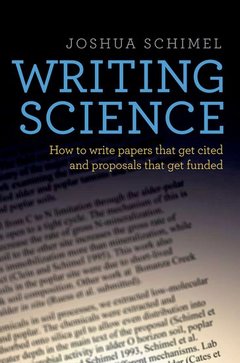Writing Science How to Write Papers That Get Cited and Proposals That Get Funded
Langue : Anglais
Auteur : Schimel Joshua

As a scientist, you are a professional writer: your career is built on successful proposals and papers. Success isn't defined by getting papers into print, but by getting them into the reader's consciousness. Writing Science is built upon the idea that successful science writing tells a story. It uses that insight to discuss how to write more effectively. Integrating lessons from other genres of writing with those from the author's years of experience as author, reviewer, and editor, the book shows scientists and students how to present their research in a way that is clear and that will maximize reader comprehension. The book takes an integrated approach, using the principles of story structure to discuss every aspect of successful science writing, from the overall structure of a paper or proposal to individual sections, paragraphs, sentences, and words. It begins by building core arguments, analyzing why some stories are engaging and memorable while others are quickly forgotten, and proceeds to the elements of story structure, showing how the structures scientists and researchers use in papers and proposals fit into classical models. The book targets the internal structure of a paper, explaining how to write clear and professional sections, paragraphs, and sentences in a way that is clear and compelling. The ideas within a paper should flow seamlessly, drawing readers along. The final section of the book deals with special challenges, such as how to discuss research limitations and how to write for the public. Writing Science is a much-needed guide to succeeding in modern science. Its insights and strategies will equip science students, scientists, and professionals across a wide range of scientific and technical fields with the tools needed to communicate effectively.
Preface. Acknowledgments. 1 Writing in science. 2 Science writing as story telling. 3 Making a story sticky. 4 Story Structure. 5 The Opening. 6 The Funnel: connecting O and C. 7 The Challenge. 8 The Action. 9 The Resolution. 10 Internal Structure. 11 Paragraphs. 12 Sentences. 13 Developing flow. 14 Energizing writing. 15 Words. 16 Condensing. 17 Putting it all together: real editing. 18 Dealing with limitations. 19 Writing global science. 20 Writing for the public. 21 Resolution. App. A: My Answers to Exercises. App. B: Resources.
Joshua Schimel is Chair of the Environmental Studies Program and Professor Professor of Soil and Ecosystem Ecology at the University of California, Santa Barbara. He is a leading environmental scientist, studying how soil processes regulate ecosystems and the earth's climate. He has authored over 100 papers and has served on panels for the National Science Foundation, NASA, and other agencies.
Date de parution : 12-2011
Ouvrage de 240 p.
15.6x23.3 cm
Date de parution : 01-2012
Ouvrage de 240 p.
16.2x23.6 cm
© 2024 LAVOISIER S.A.S.



